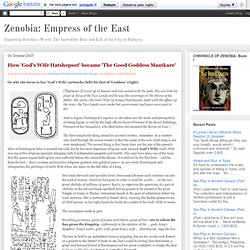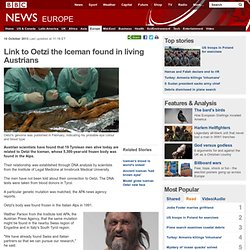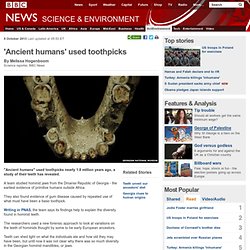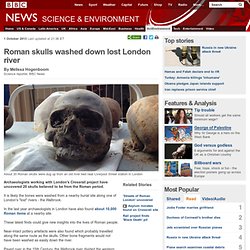

Northern 'Atlantis' Wiped Out By Ancient Tsunami. An ancient civilisation located on a North Sea 'Atlantis' was wiped out by a huge tsunami, a new theory suggests.

The islands known as 'Doggerland' were a stretch of land masses - some very small, others roughly half the size of Wales - existed between England and Europe until about 8.200 years ago. The islands were low-lying but were occupied by Mesolithic tribes. Described as a prehistoric "garden of Eden" artefacts including fishing nets and flint tools have been found in the area, which is now covered in the sea.
But according to research by scientists at Imperial College, it was subsumed after a catastrophic landslide which occurred near Norway. The so-called Storegga slide - which was enormous, at 3,000 cubic km - created a tsunami at least 5 metres high, which covered the islands in water, and wiped out the last human settlers. Long-Term Drought Doomed Indus Valley Civilization, Researchers Say. 'Major' Byzantine-Era Church With Stunning Mosaic Unearthed In Israel (PHOTO) ©2014 MapQuest - Some data ©2014 Natural EarthNatural Earth | Terms Excavations prior to the construction of a new neighborhood in Israel have turned up the ruins of a 1,500-year-old Christian church with a beautiful mosaic.

Archaeologists found the Byzantine-era church in Aluma, a town 30 miles south of Tel Aviv, according to a press release from the Israel Antiquities Authority. Ruins Near Giza Pyramids Reveal Luxurious Lifestyle Of Ancient Egypt's Elites. Vikings Beheaded, Buried Slaves As 'Grave Gifts,' New Study Suggests. Were the Vikings even more brutal than we realized?

From the ninth century to the 11th century, marauding Viking warriors laid waste to a broad swath of Europe, and in the process often took slaves for physical labor and sex. Now researchers from the University of Oslo in Norway say they've found new evidence suggesting that when their Viking masters died, slaves were beheaded and buried along with them. Elise Naumann, an archaeologist at the university, and her colleagues reached this conclusion after analyzing the skeletal remains of 10 Viking-era bodies originally discovered decades ago in Flakstad, Norway. The researchers paid particular attention to graves that contained the remains of two or more bodies -- but only one head. Roman Eagle And Serpent Sculpture Dug Up In London (PICTURES) Archaeologists have unveiled an "exceptional" Roman sculpture that was only just found hours before a dig was about to end in London.

Experts have declared the eagle clasping a serpent in its beak which was found in the City of London before the site's redevelopment into a 16-storey hotel, "the finest sculpture by a Romano-British artist ever found in London". Archaeologists also unearthed foundations of a mausoleum on the east London site and believe that the statue, dating from the first or second century AD and made from oolitic limestone from the Cotswolds, once adorned it. Story continues after slideshow... Loading Slideshow. 4,000-Year-Old Tomb Of Doctor To The Pharaohs Discovered (PHOTO)
Empress of the East: How 'God's Wife Hatshepsut' became 'The Good Goddess Maatkare' If you haven't read the previous post (Hatshepsut Cheek by Jowl with Judy Chicago), you might have a look at that first.

Or why she turns in her 'God's Wife' cartouche (left) for that of 'Goddess' (right) [Thutmosis II] went up to heaven and was united with the gods. His son took his place as King of the Two Lands and he was the sovereign on the throne of his father. His sister, the God's Wife [of Amun] Hatshepsut, dealt with the affairs of the state: the Two Lands were under her government and taxes were paid to her. Zenobia: Empress of the East. Etruscan Warrior Prince Actually A Princess, Bone Analysis Reveals. This 1,600-Year-Old Goblet Shows that the Romans Were Nanotechnology Pioneers. A Roman bathhouse still in use after 2,000 years. 12 October 2013Last updated at 21:17 ET Roman ruins are rarely boisterous places, full of noise, laughter and life.

But Edward Lewis stumbled across one that is - a place to have a daily wash, and to enjoy the companionship of friends, just as it was for the Romans who built it. Observing middle-aged men swathed in white foamy soapsuds is not something I would normally write home about and it certainly wasn't why I was in north-east Algeria. 3,000 Years of Human History, Described in One Set of Mathematical Equations. Most people think of history as a series of stories—tales of one army unexpectedly defeating another, or a politician making a memorable speech, or an upstart overthrowing a sitting monarch.

Peter Turchin of the University of Connecticut sees things rather differently. Formally trained as a ecologist, he sees history as a series of equations. Specifically, he wants to bring the types of mathematical models used in fields such as wildlife ecology to explain population trends in a different species: humans. Ancient Skeletons Reveal Genetic History of Central Europe. This 1,600-Year-Old Goblet Shows that the Romans Were Nanotechnology Pioneers.
A Roman bathhouse still in use after 2,000 years. Link to Oetzi the Iceman found in living Austrians. 10 October 2013Last updated at 11:18 ET Oetzi's genome was published in February, indicating his probable eye colour and blood type Austrian scientists have found that 19 Tyrolean men alive today are related to Oetzi the Iceman, whose 5,300-year-old frozen body was found in the Alps.

Their relationship was established through DNA analysis by scientists from the Institute of Legal Medicine at Innsbruck Medical University. The men have not been told about their connection to Oetzi. The DNA tests were taken from blood donors in Tyrol. A particular genetic mutation was matched, the APA news agency reports. 'Ancient humans' used toothpicks. 8 October 2013Last updated at 05:53 ET By Melissa Hogenboom Science reporter, BBC News "Ancient humans" used toothpicks nearly 1.8 million years ago, a study of their teeth has revealed.

Roman skulls washed down lost London river. 1 October 2013Last updated at 21:36 ET By Melissa Hogenboom Science reporter, BBC News About 20 Roman skulls were dug up from an old river bed near Liverpool Street station in London Archaeologists working with London's Crossrail project have uncovered 20 skulls believed to be from the Roman period.

Is This How Our Ancestors Sounded? Linguist Recreates Proto-Indo-European Language (AUDIO) What did our ancient ancestors sound like? Between approximately 4,500 and 2,500 B.C., the ancestors of much of Europe and Asia once spoke the same mother tongue, a language referred to as Proto-Indo-European, or PIE. Although there is no written record of such a language, linguist Dr. Andrew Byrd recently attempted to reconstruct his own recordings of PIE language for Archaeology magazine, building off three centuries' worth of scholarly work on the topic. Byrd is an expert in ancient Indo-European linguistics, focusing on phonology, and teaches at the University of Kentucky. Etruscan Prince's Tomb Found Intact In Italy After 2,600 Years (PHOTOS) Dog Mummy In Egypt Was Infested With Bloodsucking Parasites, Archaeologists Say. A dog mummy has revealed the first archaeological evidence of bloodsucking parasites plaguing Fido's ancestors in Egypt during the classical era of Roman rule.
The preserved parasites discovered in the mummified young dog's right ear and coat include the common brown tick and louse fly — tiny nuisances that may have carried diseases leading to the puppy's early demise. New timeline for origin of ancient Egypt. 3 September 2013Last updated at 20:51 ET By Rebecca Morelle Science reporter, BBC World Service Archaeological digs in Egypt reveal where the First Dynasty kings of Egypt are buried - but until now a timeline has been difficult to establish A new timeline for the origin of ancient Egypt has been established by scientists. Hot summer unearths Roman discoveries in Wales. 10 August 2013Last updated at 10:40 ET Continue reading the main story.